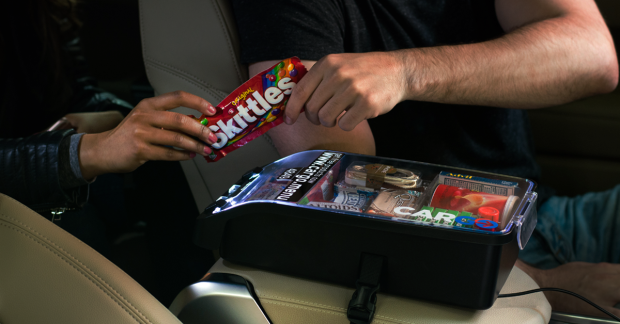Why Every Uber Needs A Vending Machine

Two typical Uber use cases:
Harried business traveler in a rush to get to the airport, who realizes three minutes after getting in the car that he’s left his headphones in his gym bag.
Guy on his way to pick up his date on Saturday night, who realizes he forgot to buy breath mints or gum.
The solutions used to involve buying overpriced headphones at the airport, or asking the Uber driver to stop at a convenience store to buy gum or mints.
But now, in Boston, New York and Chicago, those passengers no longer have to do without or encounter frictions to get what they want or need. Cargo, maker of the only vending solution that works in a moving vehicle, gives Uber drivers the ability to sell those items to a consumer during their ride.
“We’re probably not going to change anyone’s life with this service,” Cargo CEO Jeff Cripe joked with Karen Webster on their podcast, “but we are going to offer them an efficiency that will greatly improve their day, especially during their commute. After all, even people taking the ride of shame home the next day need to hydrate.”
After all, he noted, travelers need headphones, people going on dates need mints, people who’ve stayed out all night partying need aspirin, a drink and a snack – and Uber is the perfect context to reach many of those potential customers. And while the use cases can be amusing, Cripe admitted, the challenge of actually providing a way to transact with ready-to-buy consumers is pretty seriously hard to unlock.
Cargo’s key of choice? The Cargo Box, the vending machine designed to ride along in a rideshare.
In-Car Vending
Two billion hours of rides are happening via ridesharing platforms today, Cripe told Webster, not to mention the 20 billion hours forecasted to accrue by the year 2030. It’s why equipping rideshare vehicles with in-car vending capabilities makes perfect sense.
If properly executed.
Cripe explained that putting a vending machine in a car is not quite as simple as miniaturizing the more traditional machines that dispense cold beverages and salty snacks and figuring out a way to plug them into a cigarette lighter.
As it turns out, the traditional “coil-backed” models won’t work in a moving car, which meant Cargo’s co-founder and resident “hardware guy” Jasper Wheeler had to redesign the vending machine to fit onto the center console of an automobile, space that is available in 95 percent of vehicles. Or, as Cripe described it, “a slightly beautified electronics display strapped to that center console.”
The Cargo Box itself, he noted, has been optimized for both drivers and consumers to interact with minimal friction. Drivers do not pay for the machine, nor are they responsible for ordering stock for it (though they are given extra supplies to keep in the trunk for sporadic outages). The firm’s software keeps track of orders and sends resupply on an automated basis. For their trouble driving around with the machine, drivers receive 25 percent of sales, plus bonuses for clearing certain volumes and referring other drivers.
“We don’t want the drivers to be salesmen for us – we want them to drive,” Cripe said. “We tend to think of them as our landlord partners, as they operate the real estate that our commerce platform functions on.”
Customers access the Cargo Box and pay for what they want to buy without having to download a special app – instead, they can scan a QR code on the machine itself, or go to a web interface to complete the transaction.
“This is designed to be done in one or two taps, so the customer doesn’t have a long registration process – otherwise, it really defeats the convenience purpose of this,” said Cripe.
What People Are Ordering
Although Cargo is in early days and is still generating data, some early favorites have already emerged.
“People say they want to eat healthy, and I believe they do. But people also like to indulge, so we see massive sales in sugary and salty snacks,” Cripe pointed out.
He noted that’s not a huge surprise, given the historical purpose of vending machines – but on a more surprising note, people also favor the Cargo Box for electronics. And, Cripe told Webster, though they have stuck to inexpensive electronics in the past, the demand they are seeing now is for higher-end products. Few customers are looking to spend a few hundred dollars in the back of a rideshare, but more than the company anticipated are looking to spend anywhere from $30 to $50 to buy a slightly better-quality product.
“We’ve also seen that use cases vary based on when the person is in the rideshare – early in the morning, during the evening commute and late at night are the peak times, and they all have different needs.”
The AM riders, he noted, are hungry and generally looking for caffeine. Very early morning riders are more likely to be hungover. Evening riders are also looking for a snack – but they are also more likely to grab a pick-me-up in the form of a Vitamin C boost.
And, Cripe noted, what they know now – after a few hundred thousand rides and a few hundred thousand transactions – pales in comparison to what they will learn as the service continues to grow.
“We are on track to distribute around six million goods this year – and that will give us a massive trove of data on what products are being dispersed, where and at what velocity,” said Cripe. “That will give us a huge ability to optimize for geography, time of day and locations. What we are really building is a heat map of what sells, where and when, so we can best optimize that pathway.”
A pathway, he noted, that will only become more important as the automotive world keeps evolving.
What’s Next
Today, Cripe noted, the opportunity for Cargo is in ridesharing – as consumers will be in the back of these vehicles more often, it becomes more important to optimize the real estate. Going forward, as cars are becoming autonomous and people’s interactions with them may shift even more fundamentally away from ownership, the ability to provide customers with built-in commerce opportunities will only be a bigger focus.
The challenge for Cargo Box, Cripe told Webster, is moving forward with discipline, focusing on the three currently active markets and getting to full robust penetration, rather than trying to take on every market where there is interest.
“Today, we are in New York, Boston and Chicago, but we get interest in drivers from all over the country. The temptation is always to go big and broad.”
But, Cripe pointed out, when they look at the data from places like the Chicago exurbs, they see a pattern. As the service becomes more ingrained in areas and as customers encounter it more often, they use it more and spend more.
Cargo Box makes money in two ways. The first is standard retail operating procedure: They sell goods in the box at a mark-up and profit on the margins. But they also have relationships with brands, as their product offers a unique chance for them to tap into a captive audience. Each Cargo Box comes with one or two free items in the box, and those are samples that brands want to introduce to consumers. And it works.
“I recently learned, after like 10 years of not having them, that I love Skittles – and that is the exact experience brands are looking to generate,” Cripe said.
That combination – captive rider and geographic density – gives Cargo the opportunity to create its own platform that leverages Uber’s platform – an ecosystem of riders, drivers and brands – who want access to a targeted and captive audience riding in those cars. Drivers are incented to make the products available, as they get to pocket a cool $150 a month with a value-added service. Riders aren’t price sensitive, since they need or want what is being sold. And brands can get anonymized aggregated data on who is buying their products, and where.
It’s a virtuous cycle that Cripe predicted is only going to grow: Consumers are spending more time in rideshares, drivers are looking for more efficient ways to monetize their time and brands need new ways to get their products in front of customers.
And Cargo, Cripe said, has a solution for all of them – and that solution literally comes neatly wrapped up in a single (Cargo) box.
